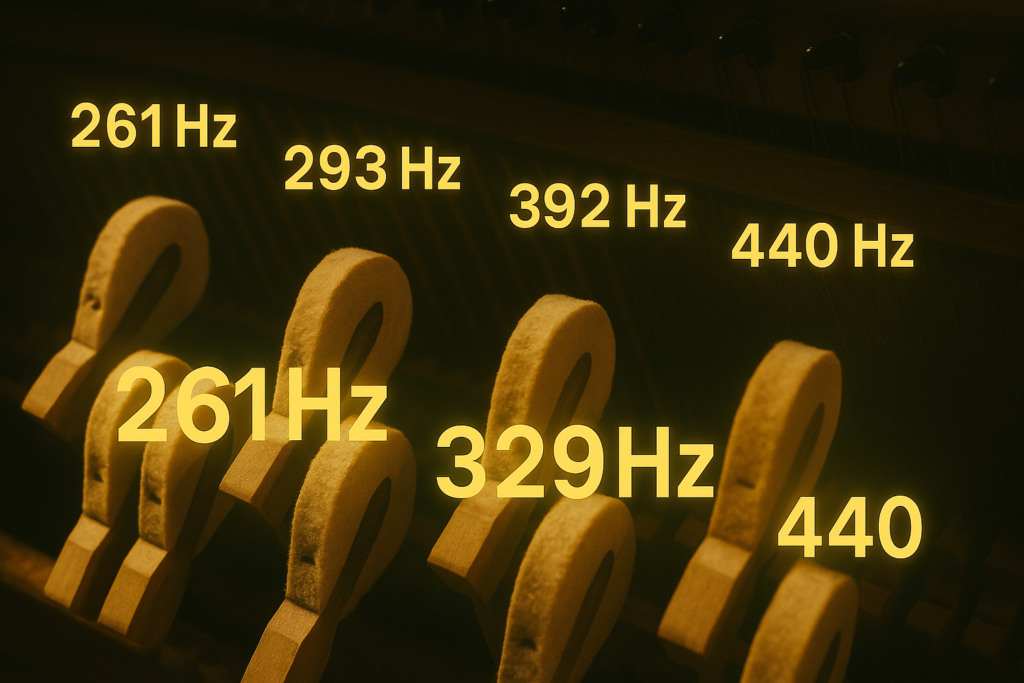Introduction
The piano is one of the most versatile and widely used musical instruments, capable of producing a vast range of tones. Behind every note lies a precise scientific principle—sound frequency. Understanding piano note frequencies is essential for tuning, composing, and even digital music production.
In this guide, we’ll explore how piano keys correspond to frequencies, the impact of standard tuning (A440), differences between acoustic and digital pianos, how to use frequency charts for tuning, and common frequency-related issues and fixes.
How Piano Keys Correspond to Frequencies
A standard piano has 88 keys, spanning seven octaves plus a minor third (from A0 to C8). Each key produces a distinct frequency, following the 12-tone equal temperament (12-TET) tuning system.
Frequency Calculation
The frequency of each note is determined by the formula:
[ f(n) = 440 \times 2^{(n-49)/12} ]
Where:
- ( f(n) ) = frequency of the nth key
- ( n ) = piano key number (A4 is key 49)
For example:
- A4 (440 Hz) is the reference pitch (key #49).
- Middle C (C4) is key #40, with a frequency of 261.63 Hz.
- A0 (lowest piano note) is key #1, vibrating at 27.5 Hz.
Octave Relationships
Each octave doubles the frequency:
- A3 = 220 Hz (half of A4)
- A5 = 880 Hz (double of A4)
This exponential increase means higher notes have rapidly rising frequencies.

Easily convert frequency in Hz to musical notes, MIDI numbers, and pitch in cents. Use this fast, accurate online frequency-to-note converter tool, ideal for musicians, producers, and audio engineers.
Standard Tuning (A440) and Its Impact
The A440 standard means the A above middle C (A4) is tuned to 440 Hz. This convention was adopted in 1939 and remains the global tuning reference for most Western music.
Why A440?
- Ensures consistency across instruments and ensembles.
- Balances brightness and warmth in orchestral tuning.
- Allows digital instruments and software to maintain uniformity.
Alternative Tunings
Some musicians experiment with different reference pitches:
- A432 Hz – Believed by some to have a “softer,” more natural resonance.
- A442 Hz – Used by some orchestras for a brighter, more projecting sound.
However, deviations from A440 can cause compatibility issues in ensemble playing.
Frequency Differences Between Grand Pianos & Digital Keyboards
Acoustic Pianos (Grand & Upright)
- String Length & Material – Longer strings in grand pianos produce richer harmonics.
- Inharmonicity – Higher notes on real pianos have slightly stretched frequencies due to string stiffness.
- Dynamic Response – Harder strikes increase volume and subtly alter overtone distribution.
Digital Pianos & Keyboards
- Sampled Sounds – High-quality digital pianos use recordings of real pianos, replicating their frequency response.
- Synthetic Tones – Lower-end keyboards generate notes digitally, sometimes lacking natural harmonic complexity.
- Perfect Tuning – Digital pianos don’t require tuning but may sound “sterile” compared to acoustic pianos.
Which Is More Accurate?
- Acoustic pianos have natural imperfections that contribute to their warmth.
- Digital pianos offer precise tuning but may lack depth in higher frequencies.
How to Use Frequency Charts for Tuning
Piano tuners rely on frequency charts to ensure each note is at the correct pitch. Here’s how to use them:
Standard Piano Frequency Chart (A4 = 440 Hz)
| Note | Octave 0 (Hz) | Octave 1 (Hz) | Octave 4 (Hz) | Octave 7 (Hz) |
|---|---|---|---|---|
| A | 27.50 | 55.00 | 440.00 | 3520.00 |
| B | 30.87 | 61.74 | 493.88 | 3951.07 |
| C | 16.35 | 32.70 | 261.63 | 2093.00 |
| D | 18.35 | 36.71 | 293.66 | 2349.32 |
| E | 20.60 | 41.20 | 329.63 | 2637.02 |
| F | 21.83 | 43.65 | 349.23 | 2793.83 |
| G | 24.50 | 49.00 | 392.00 | 3135.96 |
Steps for Manual Tuning
- Use a Tuner – A strobe tuner or tuning app helps match frequencies precisely.
- Start with A4 (440 Hz) – Tune this note first, then adjust others relative to it.
- Check Octaves – Ensure each octave doubles the frequency correctly.
- Account for Inharmonicity – Slightly stretch higher notes to compensate for string stiffness.
Common Frequency-Related Issues & Fixes
1. Beating (Wobbly Sound)
- Cause: Two slightly mismatched frequencies interfering.
- Fix: Adjust the tuning pin until beats disappear.
2. False Octaves
- Cause: Octaves not perfectly aligned due to poor tuning.
- Fix: Re-tune using an electronic tuner for precision.
3. Overly Bright or Dull Tone
- Cause: Uneven harmonic distribution.
- Fix: Voicing the hammers (for acoustic pianos) or adjusting EQ (for digital pianos).
4. Digital Piano Latency
- Cause: Slow processing in digital keyboards.
- Fix: Reduce buffer size in audio settings or use ASIO drivers.
5. String Stretch in Acoustic Pianos
- Cause: Temperature/humidity changes affecting string tension.
- Fix: Regular maintenance and climate control.
Conclusion
Piano note frequencies are the backbone of musical pitch, shaping how we hear and play music. Whether you’re tuning an acoustic grand piano, adjusting a digital keyboard, or troubleshooting frequency issues, understanding these principles ensures better sound quality and musical accuracy.
By using frequency charts, recognizing the differences between acoustic and digital pianos, and knowing how to fix common problems, you can maintain perfect pitch and enjoy a richer playing experience. Keep experimenting, and let the science of sound enhance your musical journey!

